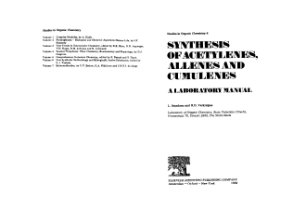Elsevier Science Publishers B.V. , 1981. – 276 p.
In 1971 we published "Preparative Acetylenic Chemistry", a collection of procedures for various acetylenic compounds. An important aim of this book was to make acetylenes more accessible, so that barriers for starting research in this field could be lowered.
The experimental work for the present book was started some years ago. It involved checking procedures from the literature and developing new ones, in some cases based on very concise instructions in preliminary papers. Host of the preparations in this book required more or less extensive research in order to find procedures for synthesizing the compounds on a reasonable scale. Im-portant aspects of this research were monitoring the conversions, in order to avoid undesirably long reaction times, and searching for efficient methods of isolation. A number of methods from the literature which seemed attractive at first sight, are not exemplified in this book, either because they could not be reproduced at all by us or because they appeared to be impractical when per-formed on a larger scale {0.1-0.2 molar).
We have exemplified the principal methods for allenes, cumulenes and also some new methods for acetylenic compounds by procedures for relatively simple structures. For each of the compounds the most suitable and economic method was selected.
We hope that our book will stimulate research in the field of unsaturated compounds and will give rise to new ideas.
Reaction vessels and some special procedures. General remarks and abbreviations
Conversion of acetylenes and cumulenes into anionic and organometallic intermediates
Derivatization of acetylenes and cumulene
Base-promoted interconversions between acetylenes and cumulenes
Synthesis of acetylenes and cumulenes by elimination reactions
Synthesis of acetylenes and cumulenes by 1,3-substitution reactions
Miscellaneous syntheses
Transformation of functional groups in acetylenes and cumulenes
In 1971 we published "Preparative Acetylenic Chemistry", a collection of procedures for various acetylenic compounds. An important aim of this book was to make acetylenes more accessible, so that barriers for starting research in this field could be lowered.
The experimental work for the present book was started some years ago. It involved checking procedures from the literature and developing new ones, in some cases based on very concise instructions in preliminary papers. Host of the preparations in this book required more or less extensive research in order to find procedures for synthesizing the compounds on a reasonable scale. Im-portant aspects of this research were monitoring the conversions, in order to avoid undesirably long reaction times, and searching for efficient methods of isolation. A number of methods from the literature which seemed attractive at first sight, are not exemplified in this book, either because they could not be reproduced at all by us or because they appeared to be impractical when per-formed on a larger scale {0.1-0.2 molar).
We have exemplified the principal methods for allenes, cumulenes and also some new methods for acetylenic compounds by procedures for relatively simple structures. For each of the compounds the most suitable and economic method was selected.
We hope that our book will stimulate research in the field of unsaturated compounds and will give rise to new ideas.
Reaction vessels and some special procedures. General remarks and abbreviations
Conversion of acetylenes and cumulenes into anionic and organometallic intermediates
Derivatization of acetylenes and cumulene
Base-promoted interconversions between acetylenes and cumulenes
Synthesis of acetylenes and cumulenes by elimination reactions
Synthesis of acetylenes and cumulenes by 1,3-substitution reactions
Miscellaneous syntheses
Transformation of functional groups in acetylenes and cumulenes

